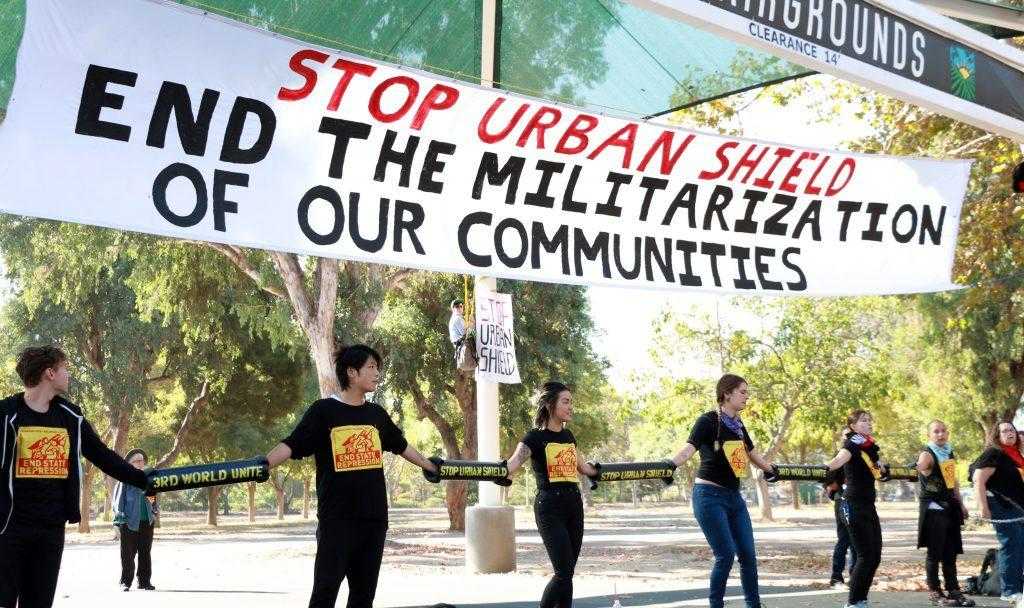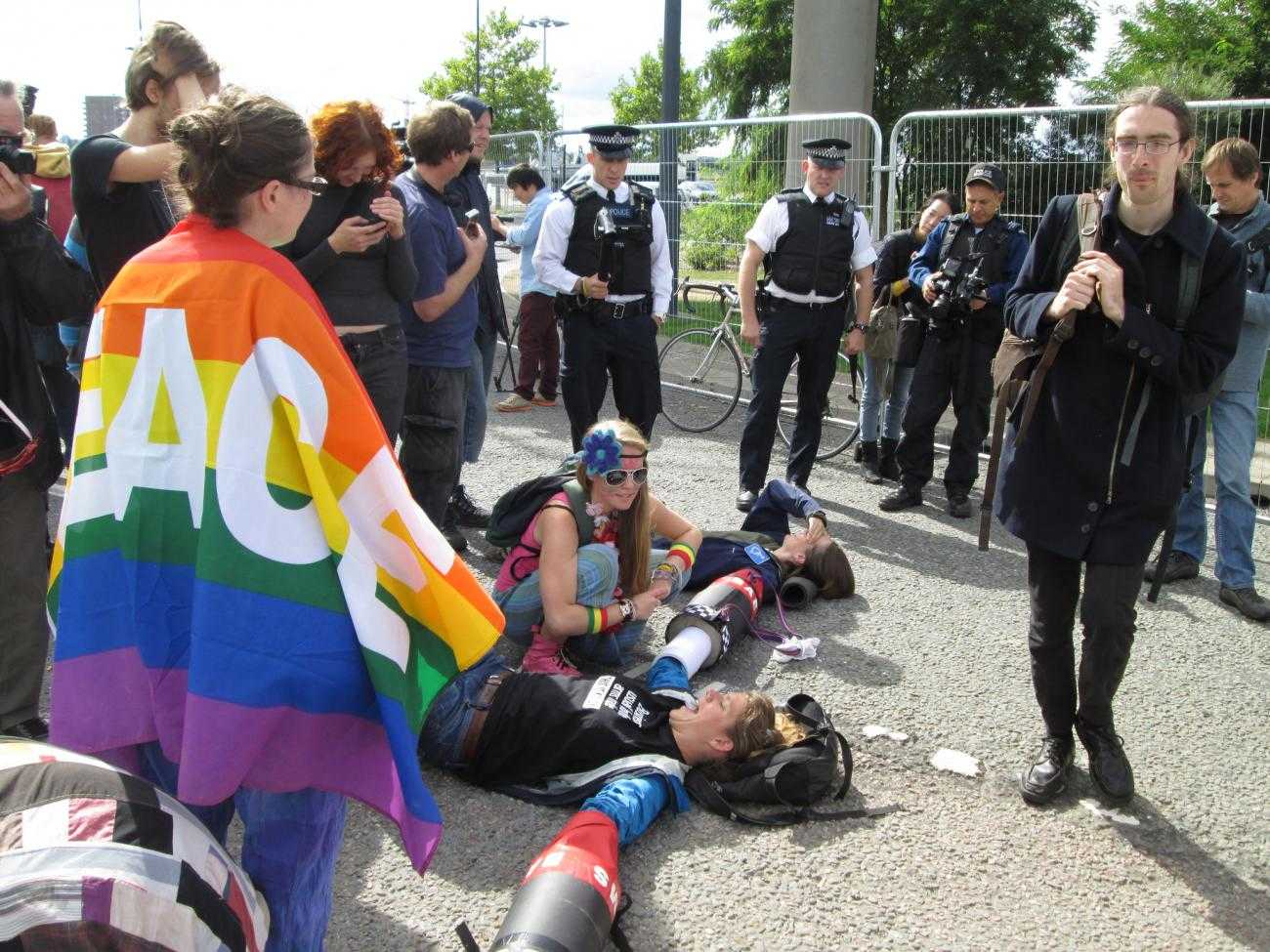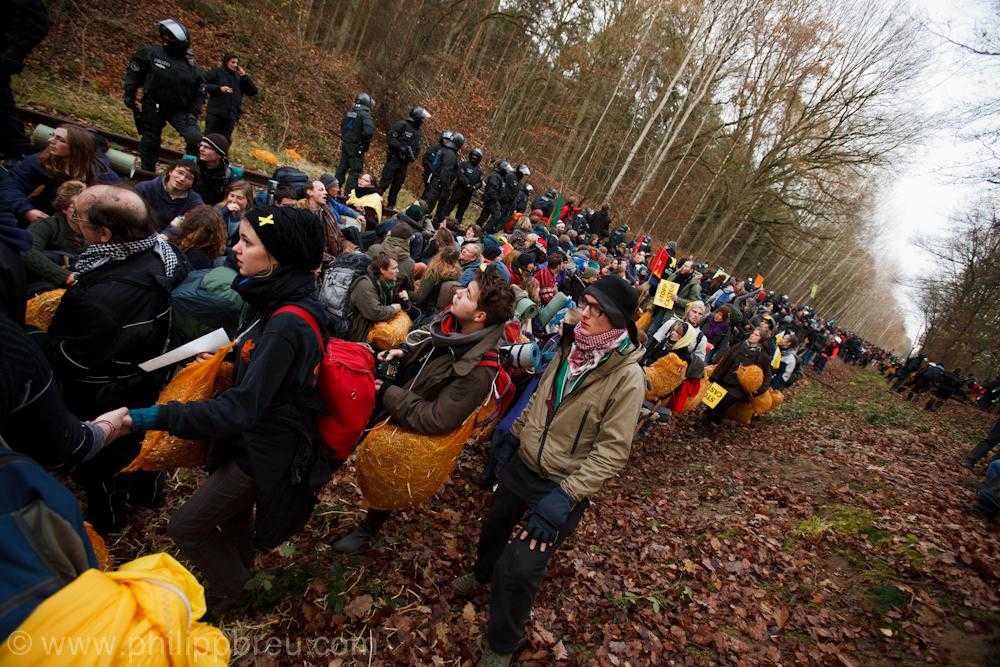There is a long tradition of people committed to social justice and political change using their bodies to disrupt the status quo, and in doing so directly challenging structures of injustice and violence. Blockades have a dual function: they have a direct and immediate impact on the target institution (by stopping or reducing its ability to function), and they provide an opportunity for activists to “point the finger”, to make an “invisible” injustice or violence, visible. Blockades can be used to disrupt, for example a board meeting, a factory, or a military base; but they can also be used to protect things which the activists don’t want to be destroyed, such as a protest camp, a community resource, or an ancient woodland.
The target and timing
Activists have blockaded everything from a single doorway to huge convention centres (such as during the protests in Seattle against the World Trade Organisation in 1999). Some targets will be relatively simple to blockade, others immensely complicated, and the target and method you choose will frame the whole action.
As well as the “where”, think about “when” - are you aiming to disrupt a particular event or meeting? Make sure you know when it is! Is your action taking place to coincide with a particular political event? Are you aiming to get mainstream media coverage? Make sure you've sent a photo to the newsdesk in time for tomorrow's edition!
Timing can be extended to our own benefit; activists in London targeting the DSEI arms fair realised it was difficult to blockade the exhibition centre when the dealers arrived, but relatively easy to blockade the week before, when huge trucks carrying set-up equipment had to enter via two small roads.
Some blockades are intended to last just a few minutes – perhaps when the key goal is to get a good photo and avoid arrests, or to symbolically delay a meeting or event to register protest or dissent without completely stopping it. Other blockades, like the Faslane 365 protest in Scotland which demonstrated opposition to Trident nuclear missile renewal, lasted over a year!
-
Ensuring your action is as targeted as possible means you focus your resources and energy on the immediate impact. A well targeted action can also help with the narrative you give including in the press release and how it will be perceived by the general public. This can help to limit criticism – you're not aiming to upset people, and help your strategy insuring as low as possible impact on members of the public.
-
The timing of the action is as important as the physical location: do you know what time the shift at the factory changes, the participants arrive at the meeting, or other key timing information?
-
Do at least one thorough recce in advance to make sure you know the site as well as you possibly can. If possible this should be done by more than 1 person. Is there a back door that could be easily used to minimise the impact of your action? Look for “choke points” - does a wide road become narrow, or do several corridors converge? Does this offer opportunities for a simpler, more effective action? How quickly will security or police be able to respond to your action?
-
Some sites – even huge ones – are relatively easy to blockade, if they have a limited number of entrances. Others have lots of gates and are a nightmare to effectively shut down!
Preparation, planning… and being ready to change the plan
An effective blockade relies on careful preparation and planning. Participants need to know what to expect, equipment and banners may need to be built or prepared, legal issues need to be considered, the site needs to be recce’d, and plenty of other logistics need to be thought about. Clearly defined roles for everyone involved means everyone know what their responsibility is. Important things to prepare and plan include:
-
Deploying the blockade: a clear plan for getting the group in position as quickly and effectively as possible can make – or break – an action, especially if you have a small window of opportunity before the police or security scupper your plans.
-
Transport: do you need a vehicle to get everyone to the site, or to carry equipment? Are there specific requirements for the vehicle?
-
Food and water: are you planning on staying a long time? What does the group need to sustain the action?
-
Legal support: put in place a system for handling arrests, supporting those detained on the day and through and court proceedings. Check out our guide to preparing legal observation here.
-
An exit plan: you may be intending to stay until you're removed or arrested, but this may take a long time, or not even happen! As a group, discuss every eventuality. Being clear in the aims and goals of the action can help to determine how long the blockade stays in place.
-
Have a way of communicating with each other when the blockade is in place. Sometimes you may not want the police or security to hear everything you are saying to each other. It’s also important to know if there is anyone in your group who doesn’t want their name mentioned.
Despite all your preparation, you will probably need to be flexible – things don’t always go to plan! For example, if you can't make it to the ideal location to blockade, are there other opportunities, or a plan B that would allow you to meet the same goals?
Visuals: don’t “just” blockade - tell a story
Blockade actions often combine having a direct impact on a target, with communicating a message to a wider audience about the issue you are taking action on. Most people will only be aware of your action afterwards, when they see pictures or videos of the action online or in print media. Your audience may not immediately recognise the site you are blockading, the people or event you are disrupting, or know much about the issue you are acting on – they may not even immediately understand what those people lying on the road are doing! What can you do to communicate the purpose of the action quickly and easily?
-
Banners and placards can help communicate a message – they can be held by supporters, or laid on the ground if blockaders are on the floor. Similarly, lock-on equipment can be painted with a strong, simple slogan.
-
Some groups have used props or costumes to help communicate a message, for example dressing as wild animals while taking action for an environmental cause, or making lock-on devices look like missiles when protesting against a military event.
-
Are there signs or displays which tell your audience what it is you're blockading? Will they recognise the company or institution? Is the building a famous landmark, or could it be anywhere?
-
Make sure you have videographers and photographers dedicated to capturing the action. Photographers and videographers are skilled in capturing a message or a story, not just a record of what happens.
Canoes Vs. Coal from Peter Yacono on Vimeo.
Equipment (or not?)
Activists have used a huge variety of creative methods to blockade their targets, but in almost every situation the goal is to make a person or group of people difficult for authorities to move. Sometimes, that's possible through sheer numbers – enough people in a road, gate, doorway, and you’ve caused a headache! Another benefit of using an overwhelming number of people for this type of action is it focuses the minds of organisers on building relationships, effective training, and organising large, powerful movements. Movements like X-tausendmal Quer have organised blockades of many hundreds of people. There are lots of things people can do to make it more difficult to be moved – lying down, linking arms, sitting in a chain, and other methods. However, mobilising large numbers of people takes huge amounts of time and effort, and makes it much more likely that authorities will find out about your plans. That might be ok (blockades don’t have to be organised in secret), but it still presents a challenge.
If you don't have the resources to mobilise large numbers of people, want to blockade a relatively small space, or hope to maintain the blockade for many hours, then you might want to use some equipment. Different movements have used a huge range of creative options, including lock-on tubes, tripods, vehicles, bicycle locks, super glue, chains, bicycles, abseiling equipment... there are plenty of options! Some pieces of kit require specialist skills and preparation, and must to be built in a way that is safe for the activists, and for the authorities if they decide to dismantle them.
As well as choosing a particular method, you need to consider:
-
How will you get the equipment into position? If it's heavy or cumbersome, will you need a vehicle? Does this pose challenges?
-
What sort of preparation or training do you and your group need?
-
What risks are you taking? Activists using equipment are immobilising themselves, potentially making themselves very vulnerable. What can you or your group do to limit the risks involved?
Legality and safety
It's fair to assume that, in the eyes of the authorities in most jurisdictions, blockade actions will be in some way breaking the law – whether that's impeding traffic flow, stopping people going about their “lawful” business, trespassing, or any number of other ways. Make sure you know what the potential legal ramifications are for the members of your group, and communicate those clearly. It is sometimes possible to speak hypothetically with a lawyer before an action to find out potential charges.
Blockades are also potentially dangerous – when doing a blockade action, activists are putting themselves directly in the way of a source of violence or injustice. This will almost inevitably cause a response from the authorities, police, security, and this will vary significantly from one country to another. You need to be confident you have some sense of what response you may face, and plan accordingly.
In some countries police forces have specially trained police officers to take equipment apart, and the risks are relatively predictable. In other countries the response may be much more violent and unpredictable. Make sure you:
-
Document police activity: Legal observers are impartial observers dedicated to monitoring and recording police and security services during protests. Use video cameras to record as much as possible, especially when police come to remove protesters. If authorities know they are being watched, it may help to at least limit their excesses.
-
Research: how have the police responded to similar actions in your country in the past? How have they attempted to remove activists? What powers do they have? What rights do you have?
-
Prepare: spend time with your group discussing scenarios, and how you might respond.
-
Know your rights: be ready and able to effectively challenge and question violent or oppressive behaviour by the police or security.






Comments
There are no comments on this article. Have you got something related to this topic, you'd like to say? Please feel free to be the first person to make a comment.
Add new comment